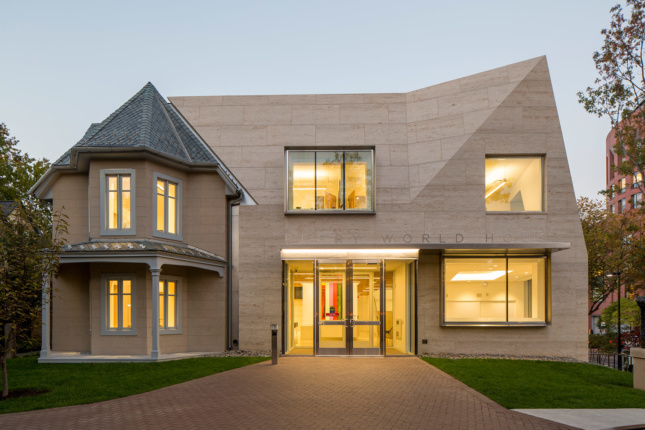
In 1865, “hat and cap merchant” Robert D. Work purchased a Gothic Revival cottage at 3803 Locust Walk in West Philadelphia, riding the wave of the migration to the suburbs. This cottage, designed by prolific architect and author Samuel Sloan, was built in 1851. It now forms part of the Perry World House—a new destination on the University of Pennsylvania’s campus courtesy of New York studio 1100 Architect.
Work’s cottage 165 years ago featured fake limestone—stucco scored to look like a French stone chateau in suburban Philadelphia. Today, the new structure, which officially opened September 20, employs a closed facade featuring real limestone blocks hanging from a steel, barn-like perimeter cage.
“The project presented the challenge of putting history adjacent to modernity in the most blunt and direct way,” said cofounder of 1100 Architect David Piscuskas. Though limestone carries connotations of weight, the facade respectfully resists falling flush to the cottage’s shingles, following this sight-line down the rest of the front elevation.
In addition, a cage structure facilitates a more or less column-free interior. This provided freedom when mapping out areas of circulation and spaces for interactivity. (The building has a capacity of 554.)
“Any structural columns that are there are hidden very well,” said Piscuskas, the soon-to-be AIA president of the New York chapter. Despite the closed facade, the building maintains a sense of transparency from both outside and within. “The way that you move through this building is celebrated and is on view at all times,” Piscuskas added. From the outside, wide, metal-framed oriel windows facing the street allow passerby to see inside: Bridges, staircases, and open social spaces are all on display.
Elements of the original structure can be found inside, too. An original wall from the cottage is near the foyer. On the second floor, a meeting room translates the language of the facade as an extrusion through the space. A pitched ceiling creates a sense of verticality resulting from combining the cottage’s original second floor and attic and restructuring the roof.
On South 38th Street, the Wharton School’s imposing building once jarred with the quaint stylings of this 19th-century cottage six lanes of traffic away. Now, its impact is less severe, thanks to the new massing that still manages to mirror and echo the former suburban vernacular. Made up almost entirely of glass fenestration, the double-height venue gets a generous dose of daylight, making it an attractive place to meet. The roof comprises a series of pitches, all varying in height, which creates a contemporary expression of the original gables.
Form was also guided by inconveniences, such as a manhole encroaching on the building’s footprint. “We saw this as an opportunity to have more fun,” said Piscuskas, who described how a chunk carved from a corner was a workaround that aligned with the rest of the building’s similar geometry. The site’s topography, too, falls in line with the angular aesthetic as open space in the rear slopes down to the street.